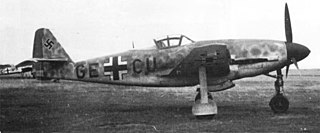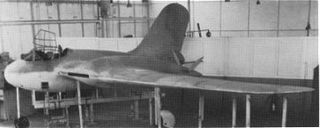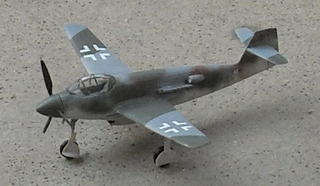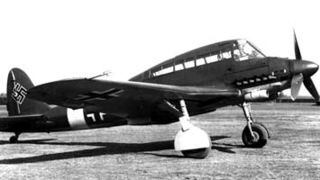
The Messerschmitt Me 210 was a German heavy fighter and ground-attack aircraft of World War II. Design started before the war, as a replacement for the Bf 110. The first examples were ready in 1939, but they proved to have unacceptably poor flight characteristics due to serious wing planform and fuselage design flaws. A large-scale operational testing program throughout 1941 and early 1942 did not cure the type's problems. The design entered limited service in 1942, but was soon replaced by the Messerschmitt Me 410 Hornisse, a further development of the Me 210. The failure of the Me 210's development program meant the Luftwaffe was forced to continue operating the Bf 110 after it had become outdated, despite mounting losses.

The Blohm & Voss BV 155 was a German high-altitude interceptor aircraft intended to be used by the Luftwaffe against raids by USAAF Boeing B-29 Superfortresses. Work started on the design as the Messerschmitt Me 155 in 1942, but the project went through a protracted development period and change of ownership, and prototypes were still under test and development when World War II ended.

The Messerschmitt Bf 110, often known unofficially as the Me 110, is a twin-engined Zerstörer, fighter-bomber, and night fighter (Nachtjäger) developed in Nazi Germany in the 1930s and used by the Luftwaffe during World War II. Hermann Göring was a proponent of the Bf 110, believing its heavy armament, speed, and range would make the Bf 110 the Luftwaffe’s premier offensive fighter. Early variants were armed with two MG FF 20 mm cannon, four 7.92 mm MG 17 machine guns, and one 7.92 mm MG 15 machine gun for defence. Development work on an improved type to replace the Bf 110 - the Messerschmitt Me 210 - began before the war started, but its shakedown troubles resulted in the Bf 110 soldiering on until the end of the war in various roles. Its intended replacements, the aforementioned Me 210 and the significantly improved Me 410 Hornisse, never fully replaced the Bf 110.

The Arado Ar 240 was a German twin-engine, multi-role heavy fighter aircraft, developed for the Luftwaffe during World War II by Arado Flugzeugwerke. Its first flight was in 1940, but problems with the design hampered development, and it remained only marginally stable throughout the prototype phase. The project was eventually cancelled, with the existing airframes used for a variety of test purposes.

The Messerschmitt Me 264 was a long-range strategic bomber developed during World War II for the German Luftwaffe as its main strategic bomber. The design was later selected as Messerschmitt's competitor in the Reichsluftfahrtministerium's Amerikabomber programme, for a strategic bomber capable of attacking New York City from bases in France or the Azores.

The Focke-Wulf Fw 191 was a prototype German bomber of World War II, as the Focke-Wulf firm's entry for the Bomber B advanced medium bomber design competition. Two versions were intended to be produced, a twin-engine version using the Junkers Jumo 222 engine and a four-engine variant which was to have used the smaller Daimler-Benz DB 605 engine. The project was eventually abandoned due to technical difficulties with the engines.

The first Messerschmitt Me 209 was a single-engine racing aircraft which was designed for and succeeded at breaking speed records. This Me 209 was a completely new aircraft whose designation was used by Messerschmitt as a propaganda tool. Although the aircraft was designed only to break speed records, it was hoped that its name would associate it with the Bf 109 already in combat service.

The Me 209 of 1943 was an attempt to create an enhanced version of the Bf 109, which served as the Luftwaffe's primary fighter aircraft throughout World War II. The Me 209, despite its designation, bore no relationship to the earlier Me 209.

The Messerschmitt Me 309 was a prototype German fighter, designed in the early years of World War II to replace the Bf 109. Although it had many advanced features, the Me 309's performance left much to be desired and it had so many problems that the project was cancelled with only four prototypes built. The Me 309 was one of two failed Messerschmitt projects intended to replace the aging Bf 109, the other being the Me 209 of 1943.

The Heinkel He 118 was a prototype German monoplane dive bomber design that lost out to the Junkers Ju 87 Stuka in the 1930s, and was never ordered by the Luftwaffe.

The Focke-Wulf Fw 57 was a prototype German heavy fighter and fighter-bomber. Prototypes were built in 1936 but never entered production.

The Henschel Hs 130 was a German high-altitude reconnaissance and bomber aircraft developed in World War II. It suffered from various mechanical faults and was never used operationally, only existing as prototype airframes.

The Dornier Do 317 was a prototype German medium bomber of World War II.
The Messerschmitt Me 265 was a design project for a Zerstörer, produced by leading German aircraft manufacturer Messerschmitt in World War II.

The Messerschmitt Me 329 was a design project for a heavy fighter and ground-attack aircraft, developed towards the end of World War II. It was a competitor and possible successor to the Me 410. Like the Me 265, the Me 329 used an advanced flying wing design. Other advanced features included the pilot and navigator sitting side by side in a broad bubble canopy, and a remote-controlled rear gun in the tail. In spite of the futuristic design, the improvement in performance over the Me 410 was marginal. Development received a low priority, and while a full-scale glider was tested at Rechlin in the winter of 1944/5, work on the project was cancelled shortly after.
The Focke-Wulf Fw 300 was a proposed very-long-range civil airliner, transport, reconnaissance aircraft and anti-ship aircraft, designed by Focke-Wulf in 1941 and 1942. The design was intended to replace the Focke-Wulf Fw 200 Condor.

The Messerschmitt Me 509 was an all-metal fighter project, underway in Germany during World War II.

The Savoia-Marchetti SM.93 was an Italian dive bomber designed and produced in Italy from 1943.

The Messerschmitt P.1111 was a jet fighter/interceptor project, designed by Messerschmitt for the Luftwaffe near the end of World War II.

















